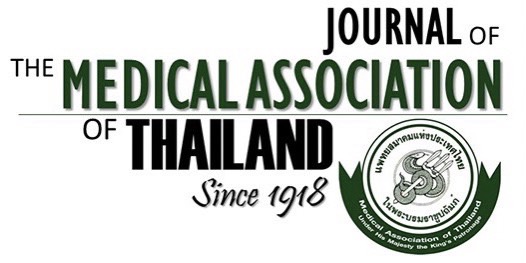Visual-Functional Mismatch and Results of Fractional Flow Reserve Guided Percutaneous Coronary Revascularization
Thamarath Chantadansuwan MD*, Wirash Kehasukcharoen MD*, Anek Kanoksilp MD*, Boonjong Saejueng MD*, Vathanyoo Plainetr MD*, Narin Sukhavasharin MD*, Sudaratana Tansuphaswadikul MD*, Kriengkrai Hengrussamee MD*
Affiliation : * Cardiology and Intervention Department, Central Chest Institute of Thailand, Nonthaburi, Thailand
Objective : To identify mismatches in the significance of coronary artery stenosis determined by physician’s visual estimation
(VE) vs. quantitative coronary angiography (QCA), by VE vs. fractional flow reserve (FFR), and independent predictors
for mismatch between VE and FFR. Second objective was to evaluate the clinical outcomes of patients receiving FFR-guided
percutaneous coronary intervention (PCI).
Material and Method: Two hundreds eighty consecutive patients (338 coronary lesions including non-left main (non-LM)
316 lesions and left main (LM) 22 lesions) underwent coronary angiography, offline edge detection QCA, and FFR
measurement between August 2011 and December 2013 were included in the present study. Baseline patient data, lesion
characteristics, and clinical outcomes were recorded and analyzed. Coronary lesions were then divided into four groups
according to FFR results and treatment (FFR <0.75 and PCI, FFR 0.75-0.80 and PCI, FFR 0.75-0.80 and defer PCI, FFR
>0.80 and defer PCI). Mismatches in the significance of coronary artery stenosis determined by VE vs. QCA, VE vs. FFR,
independent predictors of VE-FFR mismatch, and clinical outcomes after FFR-guided treatment were reported.
Results : Lesions with VE-QCA mismatch were seen in 64% of non-LM lesions and in 87% of the LM lesions. Conversely,
lesions with VE-QCA reverse mismatch were seen in 13% of non-LM lesions and in 0% of the LM lesions. Lesions with
VE-FFR mismatch were seen in 42% of non-LM lesions and in 53% of the LM lesions. Lesions with VE-FFR reverse
mismatch were seen in 15% of non-LM lesions and in 14% of the LM lesions. The independent predictors for VE-FFR
mismatch in non-LM lesions were shorter lesion and greater minimal lumen diameter. After FFR guided-treatment and
dividing coronary lesions into four groups, all patients were followed-up for a median period of 11.6 (IQR; 7.3, 17.6) months.
Major adverse cardiovascular events (excluded one death) of 338 lesions were not significantly different in the four groups
(1.7% vs. 5.1% vs. 5.3% vs. 2.7%, p = 0.717). The median cost of procedure of lesions undergone FFR plus additional PCI
was significantly higher than lesions undergone FFR only (140,000 vs. 137,000 vs. 45,000 vs. 45,000 Baht, p<0.001).
Conclusion : Mismatches between visually-estimated significance of angiographic coronary stenosis and QCA or FFR are
frequently encountered. Visual estimation of coronary angiography alone cannot entirely predict functional significance of
coronary stenosis. FFR measurement provides a helpful strategy for decision making before further revascularization.
Keywords : Fractional flow reserve, Percutaneous coronary intervention, Visual-functional mismatch, Quantitative coronary angiography



